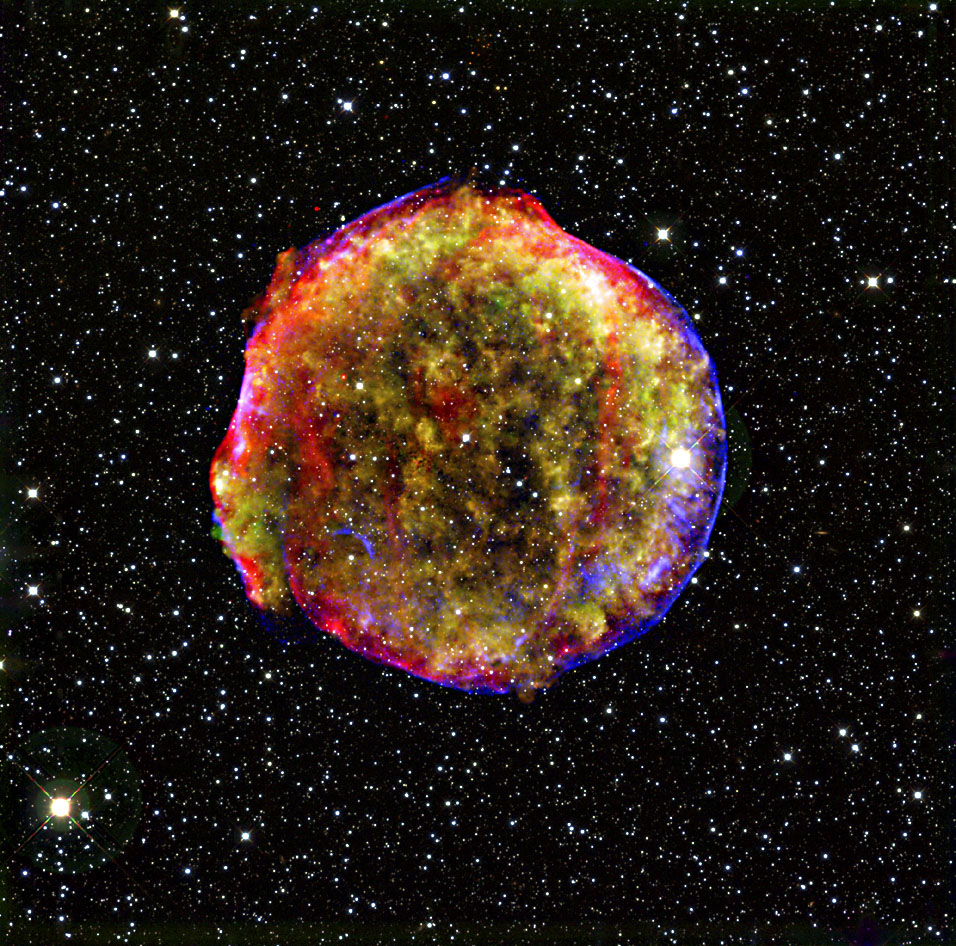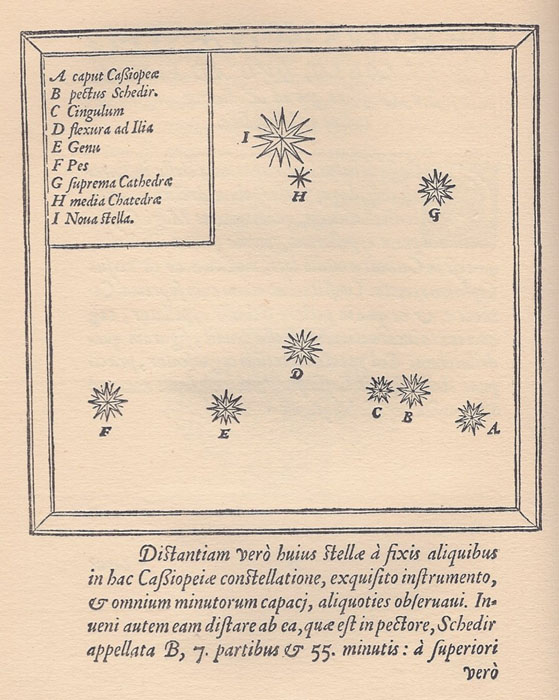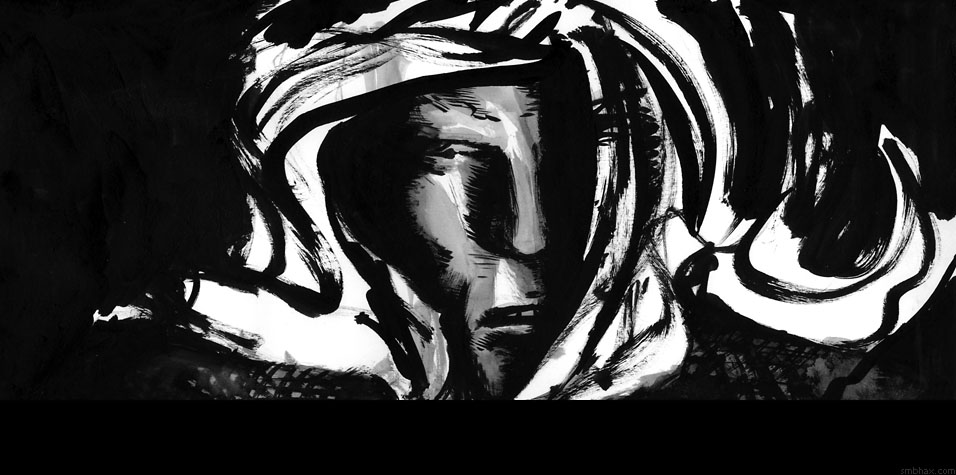Added 1 new A* page:I'm sort of surprised I never posted this NASA picture because it's one of their better known ones of our galactic scenery, I think, but better late than never:

image by NASA/CXC/SAO (X-ray), NASA/JPL-Caltech (Infrared), MPIA, Calar Alto, O.Krause et al. (Optical) (source)
^ That rainbow fuzzball is Tycho's Supernova Remnant, also known as SN 1572--which I suppose stands for "Supernova of 1572," since that was the year in which it appeared in Earthly skies: "the New Star, never before seen in the life or memory of anyone," as Danish astronomer Tycho Brahe put it in the title of a tract he published containing his detailed observations of the startling phenomenon--a newly appeared star so bright that it was visible to the naked eye in broad daylight. Here's one of the diagrams he made showing the star among other stars in the constellation Cassiopeia--it's the one marked "I" in the upper-left: "Noua Stella":

image by Tycho Brahe (source)
The apparition--one of perhaps eight supernovae visible to the naked eye in recorded history--faded from view within a few years. Thanks to the observations of Tycho and other contemporary astronomers, though, scientists armed with radio telescopes were able to locate a radio signal from its recorded position in the '50s, and achieved an optical observation of the remnant of the explosion in the '60s.
Tycho's observations and deductions of the "new star" revolutionized fundamental astronomical concepts:
| Because it had been maintained since antiquity that the world beyond the Moon's orbit was eternally unchangeable (celestial immutability was a fundamental axiom of the Aristotelian world-view), other observers held that the phenomenon was something in the terrestrial sphere below the Moon. However, in the first instance Tycho observed that the object showed no daily parallax against the background of the fixed stars. This implied it was at least farther away than the Moon and those planets that do show such parallax. He also found the object did not change its position relative to the fixed stars over several months as all planets did in their periodic orbital motions, even the outer planets for which no daily parallax was detectable. This suggested it was not even a planet, but a fixed star in the stellar sphere beyond all the planets. |
Tycho, "the last major astronomer to work without the aid of a telescope," seems to have been a pretty interesting fellow--a nobleman as well as the leading observational astronomer at the time--and the Wikipedia page on him is worth a read. But if you want something a bit more dramatic, I encourage you to check out the bit from Carl Sagan's classic "Cosmos" series dramatizing the meeting, in 1600, between Brahe and Johannes Kepler, who needed Brahe's observations of the movements of the planets--the most accurate ever made up to that time--to help work out his theories of planetary motion--these would eventually help Kepler discover that the planets move in elliptical orbits around the Sun, but not until after Brahe's death from overindulgence. That fun movie-like bit is on YouTube, beginning here. It also explains for instance why Brahe had a gold nose. :o Kepler had previously believed that the planets followed circular orbits; Brahe, for his part, did not follow the "heretical" heliocentric Copernican model of the heavens favored by Kepler, but "proposed a 'geo-heliocentric' system in which the Sun and Moon orbited the Earth, while the other planets orbited the Sun." This gained a following, particularly after 1616, when the Catholic church officially decreed that "the heliocentric model was contrary to both philosophy and Scripture."
The photo above is a false-color composite view; NASA's description runs as follows:
| The explosion has left a blazing hot cloud of expanding debris (green and yellow) visible in X-rays. The location of ultra-energetic electrons in the blast's outer shock wave can also be seen in X-rays (the circular blue line). Newly synthesized dust in the ejected material and heated pre-existing dust from the area around the supernova radiate at infrared wavelengths of 24 microns (red). Foreground and background stars in the image are white. |
Indications are that it was a Type Ia supernova, ie a white dwarf star that sucked in enough material--usually from a binary star companion--to reach the Chandrasekhar limit--the maximum mass in which matter's electron degeneracy pressure is able to resist the force of its own gravity--in other words, the point at which gravity, having squeezed the white dwarf down to just barely larger than nothing, overcomes the normal quantum mechanical laws of matter, and matter collapses entirely. Or forget that and see if you can figure out this rather more technical explanation:
| "...observe that, as we add mass to a white dwarf, its radius will decrease, so, by the uncertainty principle, the momentum, and hence the velocity, of its electrons will increase. As this velocity approaches c, the extreme relativistic analysis becomes more exact, meaning that the mass M of the white dwarf must approach Mlimit. Therefore, no white dwarf can be heavier than the limiting mass Mlimit, or 1.4 Solar masses." |
Although actually, in the case of a Ia supernova, the white dwarf doesn't *quite* reach the ~1.4 solar masses of the Chandrasekhar limit; instead, as it approaches the limit, the pressure raises the temperature, which increases the rate of fusion at the core until it reaches such a state that all the remaining carbon in the star detonates at once.
(Interestingly enough, in the past ten years or so, at least four Super-Chandrasekhar mass supernovae have been observed, starting with the Champagne Supernova of 2003; these are believed to be type Ia supernovae in which the white dwarf exceeded the Chandrasekhar limit by as much as 100% before exploding--several theories have been put forth as to how this is possible: a) the dwarf was spinning so quickly that centrifugal force helped hold it up, or b) two white dwarfs merged.)
The more spectacular nebulae tend to come from other types of supernova explosions--one where an incredibly massive star collapses all at once--but as in the case of Tycho's Remnant, Ia supernovae can still leave a pretty cool cloud of debris behind. The superhot cloud is thought to be expanding at maybe around 5,000 km/s; by way of comparison, the speed of light is 300,000 km/s.
The observations forming the above photo were done in 2003, and the photo was published in 2009. Immediately after that, though, succeeding observations would begin picking out details of the Remnant--which is maybe about 9,000 light years away and 20 light years across--that may contain clues not only to the forces driving such debris clouds, but even to how exotic cosmic rays are generated! I will get into these in another post soon. :D
~~~~~~
Here's what's on the back of today's A* page (click it for the "subscription preview" HD version):

I sketched out what would become the final page, but as a light ink sketch it looked way too...normal. So I flipped the page over and tried something a bit more dramatic and gestural, and it had some nice things in it, but the features weren't quite Thierry, you couldn't see him hiding behind the big guy, and I couldn't figure out what to do with the hair. I flipped back to the first sketch and threw some heavier black onto the eyes, the sides of the head, and the shoulder, and then it started to look a little more interesting, so I went forward with that instead.
|
